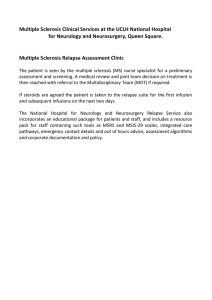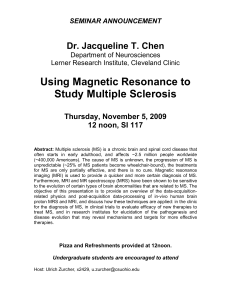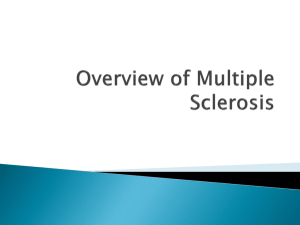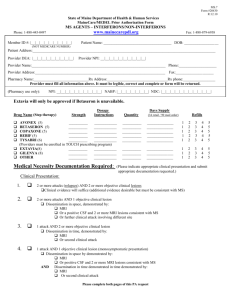Demyelinating Diseases of the central nervous system.pptx
advertisement
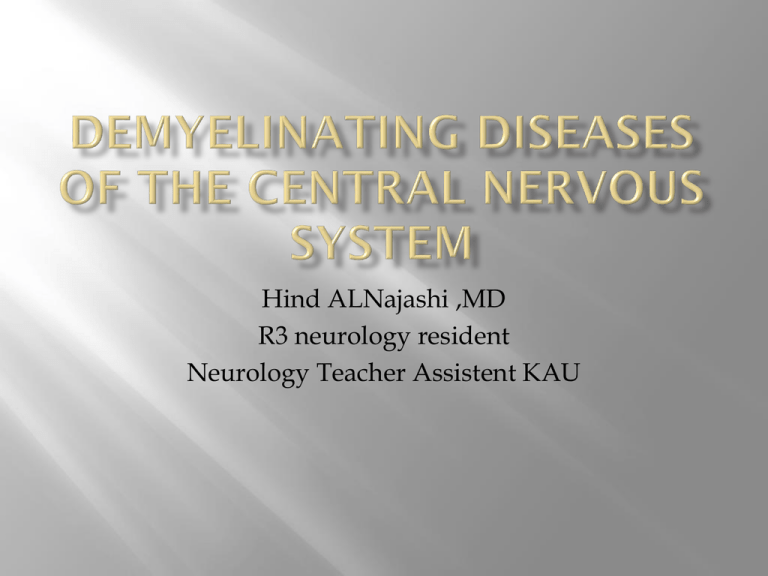
Hind ALNajashi ,MD R3 neurology resident Neurology Teacher Assistent KAU Demyelinating Diseases Demyelinating Diseases are disabling disease of the central nervous system. It result from injury to the sheath that covers the nerve fibers( myelin) in the brain, spinal cord, and optic nerves. autoimmune Herdiatry Vascular •ADEM •MS •Adrenolukodystrophy. •Krabbe’s disease. •PKU. •Binswanger’s disease. Infectious • PML Toxic/metab olic •CO •VitB12 deficency. •Hypoxia. •Alchol. •Mercury. Attacks of demylination, disseminated in time & space leaving gliotic scars (plaques) in the white matter of the brain , spinal cord and optic nerve. Autoimmune. Infection ??. Age of Onset: 29 to 32 yr. Sex: female > male. Mortality: Patients with MS tended to have normal life expectancy, and other diseases were more likely to be the cause of death. High-frequency areas of the world, with current prevalence of 60 per 100,000 or more, include all of Europe ,southern Canada, the northern United States, New Zealand, and Australia. Low-risk areas include most of South America, Mexico, most of Asia, and all of Africa. if persons migrating from an area of high risk to an area of low risk after the age of puberty carry their former high risk with them. With migration during childhood, the risk seems to be that of the new area to which the person has migrated. Clinical feature The symptoms and signs of MS are the manifestations of the pathological process seen in the CNS, namely demyelination . Symptoms Numbness or tingling in the face or limbs Impaired vision in one or both eyes, including: Blurred vision Double vision Loss of vision Eye pain Fatigue Dizziness Muscle weakness Incoordination or falling Trouble walking or maintaining balance Weakness in one or more limbs Bladder problems including: Urgency Incomplete emptying Bowel problems. Sexual dysfunction Difficulty swallowing Forgetfulness, memory loss, and confusion Depression. C/P SUGGESTIVE OF MS Heat sensitivity (uthoff’s phenomena ). Lehermitte’s sign . Optic neuritis. Involvement of multiple area of CNS. Age of onset between 15 and 50. C/P NOT SUGGESTIVE OF MS Involvement of PNS. Deficit developing within minutes. Early Dementia. Age of onset before 15 or after 50. There are several types of MS: Relapsing-remitting MS —Symptoms suddenly reappear every few years, last for a few weeks or months, then go back into remission. Symptoms sometimes worsen with each occurrence. Primary progressive MS —Symptoms gradually worsen after symptoms first appear. Relapses and remissions usually do not occur. Secondary progressive MS —After years of relapses and remissions, symptoms suddenly begin to progressively worsen. Progressive relapsing MS —Symptoms gradually worsen after symptoms first appear. One or more relapses may also occur. Sex: MS appears to follow a more benign course in women than in men. Onset at an early age is seemingly a favorable factor, whereas onset at a later age carries a less favorable prognosis. Initial complaints: impairment of sensory pathways or cranial nerve dysfunction, has been found in several studies to be a favorable prognostic feature. Although the diagnosis of MS remains clinical, a number of ancillary laboratory tests can aid in the diagnosis of MS. Neuroimaging, particularly MRI, usually provides the most critical information. MRI Evidence Of Dissemination In Space is when three out of four criteria are seen: 1 Gd-enhancing or 9 T2 hyperintense lesions if no Gd-enhancing lesion 1 or more infratentorial lesions 1 or more juxtacortical lesions 3 or more periventricular lesions (1 spinal cord lesion can replace a missing infratentorial lesion and contribute to the 9 T2-lesions). MRI Evidence Of Dissemination In Time is defined as: A Gd-enhancing lesion demonstrated in a scan done at least 3 months following onset of clinical attack at a site different from attack Any new T2 lesion detected in a scan done at any time compared to a reference scan done at least 30 days after initial clinical event. Circled is an active lesion, showing hyperintensity on T2-weighted images (A), hyperintensity on postgadolinium T1-weighted images (B), hypointensity on T1-weighted images without gadolinium (C). MRI IN MULTIPLE SCLEROSIS. Bermel, Robert; Fox, Robert © 2010 American Academy of Neurology. Published by Lippincott Williams & Wilkins, Inc. 2 The appearance of a single lesion on MRI is never pathognomonic of the disease, but some distributions and types of lesions are highly suggestive while others should raise considerable suspesion of the clinical diagnosis. Classic Characteristics of Typical Multiple Sclerosis Lesions on T2-Weighted Brain Imaging MRI IN MULTIPLE SCLEROSIS. Bermel, Robert; Fox, Robert CONTINUUM: Lifelong Learning in Neurology. 16(5) Multiple Sclerosis:37-57, October 2010. DOI: 10.1212/01.CON.0000389933.77036.14 © 2010 American Academy of Neurology. Published by Lippincott Williams & Wilkins, Inc. 2 MAGNETIC RESONANCE IMAGING IN MULTIPLE SCLEROSISWolinsky, Jerry CONTINUUM: Lifelong Learning in Neurology. Multiple Sclerosis. 10(6):74-101, December 2004. This is a parasagittal fluidattenuating inversion recovery image from a 23year-old woman with relapsing-remitting multiple sclerosis of 2 years' duration. The image shows two well-defined lesions arranged perpendicular to the lateral ventricle within the corpus callosum, one with a flamelike appearance. This characteristic pattern suggests the classic neuropathologic description of "Dawson's fingers" for plaques centered on the draining veins and is a finding highly suggestive of multiple sclerosis. © 2004 American Academy of Neurology. Published by Lippincott Williams & Wilkins, Inc. 2 This transaxial T2weighted image shows multiple well-defined brain stem lesions. Note also the juxtacortical lesion in the left inferior temporal white matter. MAGNETIC RESONANCE IMAGING IN MULTIPLE SCLEROSIS. Wolinsky, Jerry Inc. © 2004 American Academy of Neurology. Published by Lippincott Williams & Wilkins, 2 Typical changes of multiple sclerosis (MS) in the brain on axial FLAIR images (A). Note the periventricular ovoid lesions oriented perpendicular to the lateral ventricle, and lesions in the corpus callosum, with predilection for the frontal and posterior horns. Sagittal FLAIR (B) is a useful sequence for identifying MS lesions.FLAIR = fluidattenuated inversion recovery. MRI IN MULTIPLE SCLEROSIS. Bermel, Robert; Fox, Robert © 2010 American Academy of Neurology. Published by Lippincott Williams & Wilkins, Inc. 2 Typical for MS in this case •Involvement of the temporal lobe (red arrow) •Juxtacortical lesions (green arrow) touching the cortex •Involvement of the corpus callosum (blue arrow) •Periventricular lesions - touching the ventricles White matter lesion is not always Multiple sclerosis In aging WMLs are normal findhng: Widening of sulci, periventricular caps (arrow) and bands and some punctate WMLs in the deep white matter seen. multiple WMLs in a hypertensive patient. MS is one of the most common demylinating disease. Characterized by attacks of demylination that produce the symptoms and signs related to the affected area. Possible environmental factor play role in increasing disease risk. MRI play major role in diagnosis. Be careful from MS mimickers.
